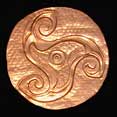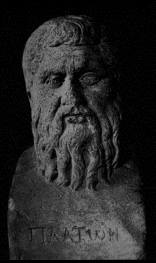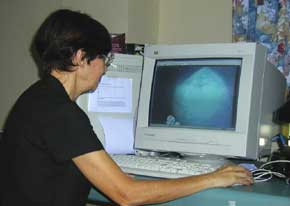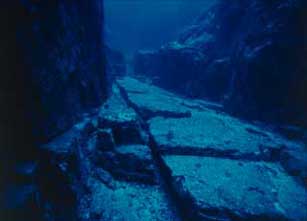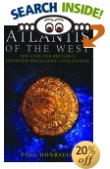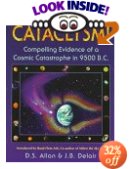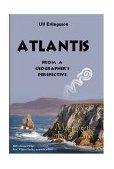|
Atlantis! Is it
myth? Was it reality? Or is the word ‘myth’
being used far too often as just a convenient term of denigration by some
in the scientific community who perpetuate erroneous views of prehistory,
and who shun debate? The myths and legends of so many peoples contain
a multitude of stories about great floods and inundations, earthquakes
and volcanic eruptions, cataclysms and catastrophes which destroyed the
paradise islands, continents and cities of their ancestors, that they
have long been suspected of having a common origin.
Since the
publication of
“Atlantis: The Antediluvian World” by Ignatius
Donnelly in 1882, there have been hundreds of books and articles written
about the subject, and to this day the legends of Atlantis and Lemuria
continue to facinate young and old alike throughout the world. The legend
of Atlantis which Plato preserved in writing, originated from Egyptian
sources – priests who claimed to have had access to the written records
of the lost island, city, continent, of Atlantis.
Dating the
destruction of Atlantis to around 9,600 BC, (11,600
years ago) Plato wrote of their elaborate system of canals
used for the irrigation of their lands, and of the high culture there.
It was from this date that some now believe the refugee survivors of the
‘Atlantean event’ introduced
agriculture to the rest of the world, though it was not until the last
50 years, and following the development of radiocarbon dating, that this
date for agricultural beginnings has been more generally accepted by archæologists.
But could
these findings, all above sea-level, be just evidence of the pityful efforts
by a few survivors of the cataclysms
that we now know marked the end of the last Ice Age? Have our archæologists
and prehistorians made a huge boob by considering only the remains of
those lucky enough to have been able to flee to higher ground? And, more
importantly, have they based the whole history of human civilisation on
this small portion of the land mass that was left above sea-level after
the end of the last Ice Age?
Geologists, now using sophisticated computer programs, can re-create the ancient sea-levels graphically, and so are able to pinpoint the areas of land that were above sea-level before the end of the last Ice Age. They have identified two specific periods of rapid sea-level risings at around 14,000 years ago and, most importantly, at around 11,600 years ago – at exactly the time that Plato gave for the inundation of the ancient civilisation he referred to as Atlantis.
More recently,
oceanographers conducting sea pollution studies in the Gulf of Khambhat
(Cambay) off the coast of Gujarat,
northwestern India, have found two
large underwater cities that are each about the size of Manhattan.
While underwater exploration in the past year has shown that archæological
urban remains similar in size exist some 2,200 feet underwater off
the coast of Cuba stretching towards the Yucatan peninsular of
Mexico. How many more ancient cities are waiting to be discovered underwater
on the continental shelves around the world?
How did Plato
know this precise date? Were the records kept by the Egyptian priests
really 9,000 years old? The best place to start would be from the writings
about Atlantis of Plato himself, which he wrote in the form of dialogues
between his teacher, Socrates, Timaeus, Critias (Plato’s
great-grandfather) and Hermocrates. Take a look at what
he had to say before you proceed further down this page.
The purpose
of this page is to introduce some of the many theories about Atlantis,
and about the evidence that is accumulating of a global catastrophe around
9,600 BC that brought cataclysmic floods, dramatic climate changes, and
as some now believe, the collapse of the ‘antediluvian
world’. This cycle of catastrophe, survival, and the rebuilding
of new civilisations from the ruins of the old, is a pattern many believe
has been repeated throughout prehistory. In the third millennium BC numerous
Bronze Age societies around the world collapsed around the same time.
Major upheavals, abrupt climate changes, and the decline of the agricultural
base, were followed by the hurried abandonment of places of long term
habitation and mass migrations by refugee survivors
to other lands. How many times has this happened before or since?
Over the
last twenty years individual scientific researchers have stepped outside
the ‘standard paradigms’ of
their respective disciplines, and begun the process of reviewing the many
archæological anomalies, and the climatological and geological inconstistencies
that have for far too long been ignored by mainstream scientists. Although
they don’t all agree on certain aspects, nevertheless their efforts are
developing a clearer view of prehistory – one that refuses to look at
the history of human civilisation on our planet from the ‘isolationist’
persepctive. The Earth does not ‘stand alone’,
unaffected by ‘events’ in the
solar system in which it exists.
Consensus
is developing that the history of human civilisation can only be fully
understood in the context of a relatively recent dynamic history of our
solar system. Collectively they have become known as the British School
of Coherent Catastrophism, (BSCC),
and while it is impossible to sum up their ‘neo-catastrophist
paradigm’ in a few short words, it is nevertheless true
to say that it centres on the growing appreciation that at various stages
during the past 20,000 to 30,000 years, and further back into remote antiquity,
our planet Earth has seen a number of disastrously abrupt climate changes
whose causes appear to have been cosmically-induced.
During the
past fifteen years there has been nothing short of a massive shift in
the the ways many scientists have begun to look at prehistory, and since
the events of July 1994, when the fragmenting comet, P/Shoemaker-Levi
9, collided with the planet Jupiter, this change has gathered
momentum. The end of the last Ice Age 10,000 – 12,000 years ago, was a
time when abrupt climatic and environmental changes took place, and it
now seems that this ‘event’ has been
repeated many times to a greater or lesser degree, before and after this
epoch, in particular during the period of the Bronze Age. The situation
is summed up well by Social Anthropologist, Dr. Benny J. Peiser, of John
Moores University, Liverpool:
“At some time around 2300 BC, a large number of major civilisations
collapsed. At the same time, there is widespread evidence for abrupt and
widespread environmental catastrophes. Sudden sea-level changes, catastrophic
inundations, widespread seismic activity and earthquake damage, changes
in glacial features and a signal for an abrupt climatic downturn have
been detected at c. 2350. A survey of some 500 excavation reports, research
papers and scientific abstract on late 3rd Millennium BC civilisation
collapse and environmental change show a distinct patttern of environmental
and social upheaval at this time.” [1]
Some recent
studies, while attempting to integrate the archæological, climatological
and geological records, have surprisingly ignored tree-ring and ice-core
data, and there is still an entrenched anti-catastrophist mentality prevailing
amongst many academics in the historical sciences generally. But that,
too, is rapidly changing:
“Over the past fifteen years, an alternative agent for natural disaster
has been much discussed and a growing number of scientists are beginning
to regard it as the most probably single explanation for widespread and
simulataneous cultural collapse, not only during the Bronze Age but at
other times as well. The new theory has been advanced largely by British
scientists such as Victor Clube and Bill Napier, Sir Fred Hoyle and Chandra
Wickramasinghe, Mark Bailey, Duncan Steel, and Gerrit Verschuur. The theory
maintains that massive cultural and historical disasters were caused by
the impact of meteor showers and other types of cosmic debris on the Earth.”
[2]
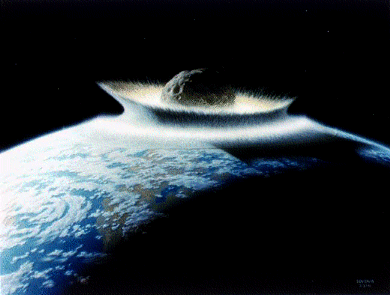
a painting by Donald E. Davis for NASA
The evidence
the BSCC is accumulating has been greatly helped by the dendrochronological
(tree-ring) records, which
are able to determine ‘exact dates’
of abrupt climate changes by virtue of the fact that each tree-ring represents
the growth of a particular tree in a single year. The leading scientist
in this field, Mike Baillie, an archæologist, at Queens University, Belfast,
in the north of Ireland, developed the computer program that allows any
piece of wood recovered during archæological excavations to be precisely
dated by it’s tree-ring pattern.
The dendrochronology
record stretches back some 8,000 years, and throughout that period Baillie
has noted numerous ‘narrowest tree-ring events’
that indicate poor annual growth. From this data Baillie has produced
several dates throughout the last 5,000 years in which the climate abruptly
changed, and he correlated these with ice-core records, marine and lake
sediment records, pollen and paleo-climatic records. He also looked for
hints in the ancient traditions and mythologies of many cultures, specifically
looking for cometary and other celestial-body imagery which he, and others
in the BSCC, regard as representing the accurate observations of ancient
skywatchers.
The dates
that emerge from the ‘narowest-ring events’ evident in the tree-ring records also correlate well with episodes
of increased meteoric activity along the model proposed by astronomers
of the BSCC. This model suggests that a large comet entered our solar
system at some point during the last 20,000 years, and following a close
encounter with the planet Mercury, disintegrated, with the Earth periodically
experiencing celestial bombardments
resulting from the encounters with the trails of debris left behind by
this comet over the past sveral thousands of years.
Baillie chronicled
these in his book, “Exodus
to Arthur”, leaving little room for doubt that the main causes
of these abrupt climate changes, and accompanying tectonic and sea-level
upheavals, were periods of bombardment by cometary debris. At the end
of the book he summed up the new understanding of human history as seen
by most BSCC scientists:
“The only remaining question is whether there has been just one close-approach comet, or several, in the last 5,000 years. The candidate dates are 2354 BC, 1628 BC, 1159 BC, 207 BC, 44 BC and AD 540.”
[3]
|
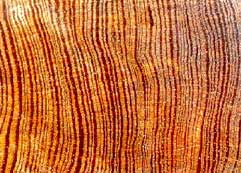
|
|
The Morien Institute has several ongoing projects focussing on some of the dates given by Baillie and Peiser. One of these is the circa 2350 BC period which saw the collapse of so many early Bronze Age civilisations around the world, from Egypt, Israel and the Undus Valley to China. Another is the c. 1159 BC period which saw the collapse of the late Bronze Age civilisations of the Aegean and the Near East. Whilst a third, and historically important ‘event’, is the c. AD 536 – 545 period which saw the final death throes of the Roman Empire, ushering in the European Dark Age that gave us the Arthurian Romances which are so full of cometary imagery.
|
Baillie in particular has shown that the legends of the arthurian ‘wastelands’ are likely to be memories of the last great encounter the Earth had with cometary debris bombardment as suggested in the tree-rings for AD 536 – 545.
The joint research of the late Sir Fred Hoyle and Chandra Wickramasinghe of the University of Wales at Cardiff, which proposes that an ocean impact of a comet-sized object was
the probable cause of the cataclysmic ending of the last Ice Age, has found a ready audience amongst those otherwise traditional academics who are beginning to listen to the arguments of the ‘coherent Catastrophist’ school of thought. The detail of the model proposes that a celestial body of sufficent volume to vaporise and eject billions of gallons of sea-water into the upper atmosphere, thereby causing an almost instant ‘greenhouse effect’, impacted a major ocean around 12-13,000 years ago.
As the ‘main greenhouse gas’ is without doubt ‘water vapour’, and as this date is consistent with the patterns of periodic encounters with the remnants of a giant comet proposed in the ‘windows of probability’ models put foward by the BSCC, the hypothesis that regular ancient bombardments of meteorites and asteroids caused the end of the last Ice Age deserves a fairer hearing than some academics seem prepared to give it.
The Morien
Institute takes the simple view that much more
evidence of prehistoric civilisation in many parts of the world,
dating from well before the sea levels rose at the end of the last Ice
Age, will come to light in the near future. Some will no doubt claim their
discoveries are the site of ‘the true Atlantis’.
Others may claim to be able to locate the actual site of the biblical
Noah’s
Flood. But most people will simply marvel at the extent of prehistoric
Ice Age civilisation that was destroyed in the many periodic cataclysms
our fragile and vulnerable planet has suffered within the last 20 millennia
or so – since the break-up of a giant comet whose remains today are to
be found in Encke’s Comet, the asteroid Hephaistos, and in the daytime
Taurid meteors. Do our cherished beliefs about the history of human civilisation
need to be radically reviewed?
So
many ‘blank’ spaces exist in
the prehistoric record that the Morien Institute
is building an information resource that Atlantis skeptics and advocates
alike can use to explore these facinating epochs of our distant past.
As more and
more ancient ruins are discovered all around the world on the continental
shelves that were submerged during
the abrupt end of the last Ice Age, our main News
Page carries reports that are updated daily.
In our Marine Archæology News Archive are links to other web sites where you can
review some of the many and varied theories about the lost continents,
islands, or cities of Atlantis. Some may well stretch credulity, and some
are highly thought-provoking, but others are closer to the truth than
‘official interpretors’ of prehistory
acknowledge …
|
